
Illustrative Math Alignment: Grade 6 Unit 3
Unit Rates and Percentages
Lesson 3: Measuring with Different-Sized Units
Use the following Media4Math resources with this Illustrative Math lesson.
| Thumbnail Image | Title | Body | Curriculum Nodes |
|---|---|---|---|

|
Closed Captioned Video: Percents: Applications of Percent -- Grade | Closed Captioned Video: Percents: Applications of Percent -- GradeTopicPercents DescriptionThis video applies percents to measure slopes or grades, using ratios for rise over run. Examples include road inclines, ski slopes, and cycling paths. Applications showcase percents in engineering, sports, and transportation, emphasizing their practicality in measuring inclines accurately. |
Percents |

|
Closed Captioned Video: Percents: Calculating Commissions and Tips | Closed Captioned Video: Percents: Calculating Commissions and TipsTopicPercents DescriptionThe video demonstrates calculating tips and commissions using percentages. Examples include restaurant tips, real estate commissions, and catering costs. Applications focus on service industry calculations and earnings management. |
Percents |
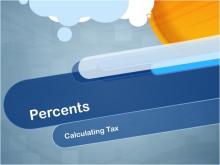
|
Closed Captioned Video: Percents: Calculating Tax | Closed Captioned Video: Percents: Calculating TaxTopicPercents DescriptionThis video covers tax calculations for purchases, property, and VAT. Examples include grocery bills, iPad purchases, and real estate property taxes. Applications highlight the importance of understanding tax rates for budgeting and financial management. |
Percents |
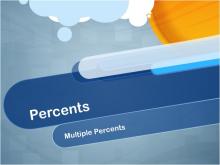
|
Closed Captioned Video: Percents: Multiple Percents | Closed Captioned Video: Percents: Multiple PercentsTopicPercents DescriptionThis video demonstrates how to handle multiple percentage changes applied sequentially, including discounts and price fluctuations. Examples include double-discounted items, stock price variations, and gasoline price changes. Applications emphasize consolidating multiple percents into single calculations for efficiency in financial and retail scenarios. |
Percents |
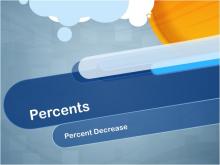
|
Closed Captioned Video: Percents: Percent Decrease | Closed Captioned Video: Percents: Percent DecreaseTopicPercents DescriptionThis video covers calculating percent decreases in scenarios such as price reductions, vehicle depreciation, and cube dimension changes. Examples demonstrate the relationship between linear decreases and their exponential effects on surface area and volume. Applications include consumer goods, real estate, and geometry. |
Percents |

|
Closed Captioned Video: Percents: Percent Increase | Closed Captioned Video: Percents: Percent IncreaseTopicPercents DescriptionThe video explains how to calculate percent increases, focusing on changes in school enrollments, asset values, and cube dimensions. Examples highlight the non-linear effects of changes on surface area and volume. Applications include finance, education, and geometry, emphasizing understanding growth trends. |
Percents |
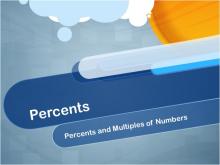
|
Closed Captioned Video: Percents: Percents and Multiples of Numbers | Closed Captioned Video: Percents: Percents and Multiples of NumbersTopicPercents DescriptionThe video explains the distinction between percent growth and multiple growth. Examples include doubling heights, stock price increases, and oil price changes. Applications emphasize clear understanding of percent versus multiplier concepts in finance and everyday math. |
Percents |

|
Closed Captioned Video: Percents: Probabilities and Percents | Closed Captioned Video: Percents: Probabilities and PercentsTopicPercents DescriptionThe video explores percent-based probabilities in scenarios like dice rolls. Examples include calculating probabilities of specific outcomes and estimating occurrences over multiple trials. Applications include games of chance and statistical analysis. |
Percents |

|
Closed Captioned Video: Percents: Simple Interest | Closed Captioned Video: Percents: Simple InterestTopicPercents DescriptionThe video explains how to calculate simple interest using a formula involving principal, rate, and time. Examples include savings account growth, stock investments, and rare coin valuation. Applications include financial planning and historical item appraisal. |
Percents |

|
Closed Captioned Video: Ratios: Application of Ratios: Roofs and Ramps | Closed Captioned Video: Ratios: Application of Ratios: Roofs and RampsTopicRatios DescriptionThe video covers practical applications of ratios for measuring slopes of roofs and ramps. Examples include comparing roof pitches, calculating base lengths of roofs, and determining ramp heights. Ratios provide clarity for gradual slopes. |
Ratios and Rates and Applications of Ratios, Proportions, and Percents |
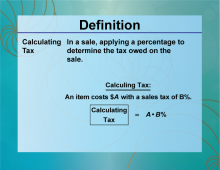
|
Definition--Ratios, Proportions, and Percents Concepts--Calculating Tax | Calculating TaxTopicRatios, Proportions, and Percents DefinitionCalculating tax involves determining the percentage amount to be added to the base price of a product or service. DescriptionCalculating tax is a fundamental application of percentages in real-world scenarios. When purchasing goods or services, the total cost is often the sum of the base price and the tax applied. Understanding how to calculate tax is essential for budgeting and financial literacy. For example, if a product costs $50 and the tax rate is 8%, the tax amount is calculated as 50 × 0.08 = 4 Therefore, the total cost is |
Applications of Ratios, Proportions, and Percents |
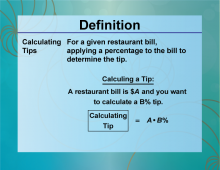
|
Definition--Ratios, Proportions, and Percents Concepts--Calculating Tips | Calculating TipsTopicRatios, Proportions, and Percents DefinitionCalculating tips involves determining the amount of money to give as a gratuity based on a percentage of the total bill. DescriptionCalculating tips is a common use of percentages in everyday life, particularly in service industries such as dining. Tips are usually calculated as a percentage of the total bill, and understanding how to compute this is important for both customers and service providers. For instance, if a meal costs $80 and you want to leave a 15% tip, the tip amount is calculated as 80 × 0.15 = 12 |
Applications of Ratios, Proportions, and Percents |
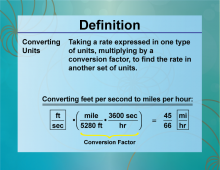
|
Definition--Ratios, Proportions, and Percents Concepts--Converting Units | Converting UnitsTopicRatios, Proportions, and Percents DefinitionConverting units involves changing a measurement from one unit to another using a conversion factor. DescriptionConverting units is essential in various fields such as science, engineering, and everyday life. It involves using ratios and proportions to switch between different measurement systems, such as converting inches to centimeters or gallons to liters. For example, to convert 5 miles to kilometers, knowing that 1 mile is approximately 1.60934 kilometers, you multiply 5 × 1.60934 = 8.0467 kilometers |
Ratios and Rates |
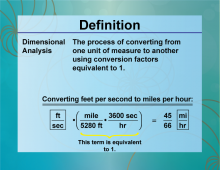
|
Definition--Ratios, Proportions, and Percents Concepts--Dimensional Analysis | Dimensional AnalysisTopicRatios, Proportions, and Percents DefinitionDimensional analysis is a method used to convert one unit of measurement to another using conversion factors. DescriptionDimensional analysis is a powerful tool in mathematics and science for converting units and solving problems involving measurements. It uses the principle of multiplying by conversion factors to ensure that units cancel out appropriately, leading to the desired unit. For example, to convert 50 meters per second to kilometers per hour, you use the conversion factors 1 meter = 0.001 kilometers and 1 hour = 3600 seconds: |
Applications of Ratios, Proportions, and Percents |
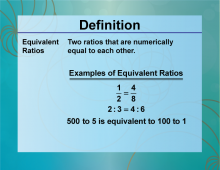
|
Definition--Ratios, Proportions, and Percents Concepts--Equivalent Ratios | Equivalent RatiosTopicRatios, Proportions, and Percents DefinitionEquivalent ratios are ratios that express the same relationship between quantities. DescriptionEquivalent ratios are fundamental in understanding proportions and scaling in mathematics. They represent the same relationship between quantities, even though the numbers themselves may differ. This concept is crucial in various applications, such as cooking, map reading, and creating models. For instance, the ratios 2:3 and 4:6 are equivalent because they both simplify to the same ratio when reduced. |
Ratios and Rates |
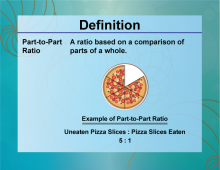
|
Definition--Ratios, Proportions, and Percents Concepts--Part-to-Part Ratios | Part-to-Part RatiosTopicRatios, Proportions, and Percents DefinitionPart-to-part ratios compare different parts of a whole to each other. DescriptionPart-to-part ratios are used to compare different parts of a whole, providing a way to understand the relationship between different components. This type of ratio is essential in fields such as statistics, biology, and economics. For example, if a class has 10 boys and 15 girls, the part-to-part ratio of boys to girls is 10:15, which simplifies to 2:3. |
Ratios and Rates |
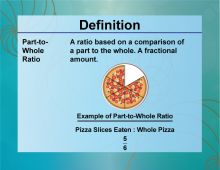
|
Definition--Ratios, Proportions, and Percents Concepts--Part-to-Whole Ratios | Part-to-Whole RatiosTopicRatios, Proportions, and Percents DefinitionPart-to-whole ratios compare one part of a whole to the entire whole. These ratios are more commonly known as fractions. DescriptionPart-to-whole ratios are used to compare a part of a whole to the entire whole, providing insights into the composition of a dataset or population. This type of ratio, more commonly referred to as fractions, is widely used in statistics, finance, and everyday decision-making. |
Ratios and Rates |
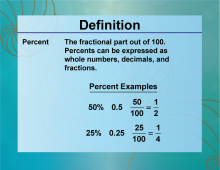
|
Definition--Ratios, Proportions, and Percents Concepts--Percent | PercentTopicRatios, Proportions, and Percents DefinitionA percent is a ratio that compares a number to 100. DescriptionPercentages are a fundamental concept in mathematics, representing a ratio out of 100. They are used in various applications, including finance, statistics, and everyday calculations such as discounts and interest rates. For example, if you score 45 out of 50 on a test, your percentage score is (45/50) × 100 = 90% |
Percents |
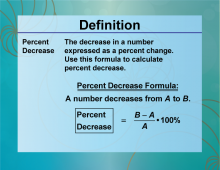
|
Definition--Ratios, Proportions, and Percents Concepts--Percent Decrease | Percent DecreaseTopicRatios, Proportions, and Percents DefinitionPercent decrease measures the reduction in value expressed as a percentage of the original value. DescriptionPercent decrease is used to quantify the reduction in value over time, expressed as a percentage of the original value. It is commonly used in finance, economics, and everyday scenarios such as price reductions and weight loss. For example, if the price of a jacket drops from $80 to $60, the percent decrease is calculated as (80 − 60)/80 × 100 = 25%. |
Percents |
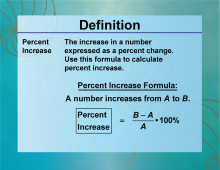
|
Definition--Ratios, Proportions, and Percents Concepts--Percent Increase | Percent IncreaseTopicRatios, Proportions, and Percents DefinitionPercent increase measures the growth in value expressed as a percentage of the original value. DescriptionPercent increase is used to quantify the growth in value over time, expressed as a percentage of the original value. It is commonly used in finance, economics, and everyday scenarios such as salary increases and population growth. For example, if the price of a stock rises from \$50 to \$75, the percent increase is calculated as (75 − 50)/50 × 100 = 50% |
Percents |

|
Definition--Ratios, Proportions, and Percents Concepts--Percent of a Number | Percent of a NumberTopicRatios, Proportions, and Percents DefinitionPercent of a number involves calculating the amount represented by a certain percentage of that number. DescriptionUnderstanding percentages is crucial for working with finances, statistics, and data analysis. For instance, to find 20% of 50, multiply 50 by 0.20, resulting in 10. Likewise, it's important for everyday scenarios, such as calculating discounts during shopping. |
Percents |
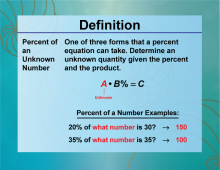
|
Definition--Ratios, Proportions, and Percents Concepts--Percent of an Unknown | Percent of an UnknownTopicRatios, Proportions, and Percents DefinitionPercent of an unknown refers to solving for an unknown quantity when given a percentage of that quantity. DescriptionKnowing how to find a percentage of an unknown variable is essential for solving equations in algebra. This concept appears in various situations, such as when determining discounts or portions of a total amount. For instance, if 20% of an unknown number equals 15, you can set up the equation: 0.20x = 15 |
Percents |
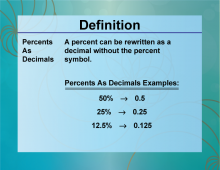
|
Definition--Ratios, Proportions, and Percents Concepts--Percents as Decimals | Percents as DecimalsTopicRatios, Proportions, and Percents DefinitionPercents as decimals involve converting a percentage into its decimal representation. DescriptionConverting percents to decimals is a key skill in mathematics, allowing students to perform calculations involving percentages more easily. To convert, divide the percent by 100. For example, 75% as a decimal is 0.75, calculated by dividing 75 by 100. This conversion is useful in many contexts, such as finance, where calculations are conducted using decimal values. Mastering this concept enables students to approach real-world problems with greater confidence and accuracy. |
Percents |
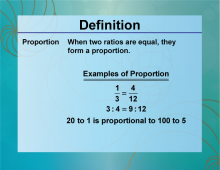
|
Definition--Ratios, Proportions, and Percents Concepts--Proportion | ProportionTopicRatios, Proportions, and Percents DefinitionA proportion is an equation that states that two ratios are equal. DescriptionUnderstanding proportions is essential in mathematics, as it is used to solve problems involving ratios and fractions. Proportions are commonly seen in real-world applications such as cooking, map measurements, and scale models. To illustrate, if there are 2 apples for every 3 oranges, the proportion can be expressed as 2:3. Solving proportions involves finding and solving an equivalent ratio. |
Proportions |
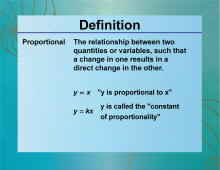
|
Definition--Ratios, Proportions, and Percents Concepts--Proportional | ProportionalTopicRatios, Proportions, and Percents DefinitionProportional refers to the relationship between two quantities where their ratio is constant. DescriptionProportional relationships are fundamental in mathematics and science, describing how one quantity changes in relation to another. This concept is used in various fields, including physics, economics, and engineering. For example, if the speed of a car is proportional to the time it travels, doubling the time will double the distance covered. Understanding proportionality helps students solve complex problems and apply mathematical reasoning in real-world situations. |
Proportions |
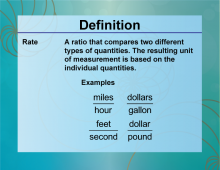
|
Definition--Ratios, Proportions, and Percents Concepts--Rate | RateTopicRatios, Proportions, and Percents DefinitionA rate is a ratio that compares two quantities with different units. DescriptionRates are used to compare different quantities, such as speed (miles per hour) or price (cost per item). Understanding rates is essential for interpreting data and making informed decisions in various contexts, such as travel and budgeting. For instance, if a car travels 60 miles in 2 hours, the rate is 30 miles per hour. Learning about rates helps students analyze real-world situations and apply mathematical reasoning to everyday problems. |
Ratios and Rates |

|
Definition--Ratios, Proportions, and Percents Concepts--Ratio | RatioTopicRatios, Proportions, and Percents DefinitionA ratio is a comparison of two quantities by division. DescriptionRatios are used to express the relationship between two quantities, providing a way to compare different amounts. They are fundamental in various fields, including mathematics, science, and finance. For example, the ratio of 4 to 5 can be written as 4:5 or 4/5. Understanding ratios helps students analyze data, solve problems, and make informed decisions in real-world situations. |
Ratios and Rates |

|
Definition--Ratios, Proportions, and Percents Concepts--Ratios and Fractions | Ratios and FractionsTopicRatios, Proportions, and Percents DefinitionRatios and fractions are both ways of comparing quantities, with fractions representing a part of a whole. DescriptionUnderstanding the connection between ratios and fractions is crucial for solving problems involving proportions and scaling. Ratios can be expressed as fractions, providing a way to understand the relationship between quantities. A fraction is a part-whole ratio. |
Ratios and Rates |
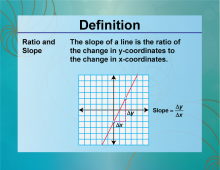
|
Definition--Ratios, Proportions, and Percents Concepts--Ratios and Slope | Ratios and SlopeTopicRatios, Proportions, and Percents DefinitionThe slope of a line is a ratio that represents the change in y over the change in x. DescriptionUnderstanding the relationship between ratios and slope is essential for interpreting graphs and solving problems in algebra and geometry. The slope is a measure of how steep a line is, calculated as the ratio of the vertical change to the horizontal change between two points. For example, if a line rises 2 units for every 3 units it runs horizontally, the slope is 2/3. This concept is crucial for understanding linear relationships and analyzing data in various fields. |
Ratios and Rates |
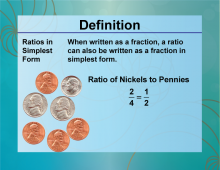
|
Definition--Ratios, Proportions, and Percents Concepts--Ratios in Simplest Form | Ratios in Simplest FormTopicRatios, Proportions, and Percents DefinitionRatios in simplest form are ratios that have been reduced to their smallest whole number terms. DescriptionReducing ratios to their simplest form is similar to the process of simplifying fractions, making it easier to compare and interpret data. A ratio is in simplest form when the greatest common divisor of the terms is 1. For example, the ratio 8:12 simplifies to 2:3 by dividing both terms by their greatest common divisor, 4. This skill is essential for solving problems involving proportions and understanding relationships between quantities. |
Applications of Ratios, Proportions, and Percents |
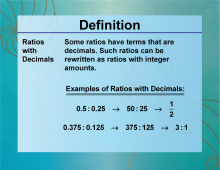
|
Definition--Ratios, Proportions, and Percents Concepts--Ratios with Decimals | Ratios with DecimalsTopicRatios, Proportions, and Percents DefinitionRatios with decimals involve comparing two quantities where one or both of the quantities are represented as decimal numbers. DescriptionRatios with decimals are crucial in various real-world applications, particularly in financial calculations, engineering, and scientific measurements. For instance, when calculating financial ratios such as the price-to-earnings ratio, decimals are often involved. Understanding how to work with these ratios allows for more precise and meaningful comparisons. |
Ratios and Rates |
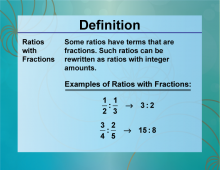
|
Definition--Ratios, Proportions, and Percents Concepts--Ratios with Fractions | Ratios with FractionsTopicRatios, Proportions, and Percents DefinitionRatios with fractions compare two quantities where one or both of the quantities are fractions. DescriptionRatios with fractions are essential in various mathematical and real-world contexts, such as cooking, where ingredients are often measured in fractions. Understanding these ratios allows for accurate scaling of recipes or other measurements. For example, if a recipe calls for 1/2 cup of sugar to 1/4 cup of butter, the ratio is 1/2:1/4, which simplifies to 2:1 by multiplying both terms by 4. |
Ratios and Rates |

|
Definition--Ratios, Proportions, and Percents Concepts--Ratios with Percents | Ratios with PercentsTopicRatios, Proportions, and Percents DefinitionRatios with percents involve comparing quantities where one or both of the quantities are expressed as percentages. DescriptionRatios with percents are widely used in various fields, including finance, statistics, and everyday life. For example, when comparing interest rates, growth rates, or discount rates, percentages are often used. Understanding these ratios allows for better financial decision-making and data analysis. |
Ratios and Rates |
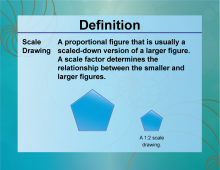
|
Definition--Ratios, Proportions, and Percents Concepts--Scale Drawing | Scale DrawingTopicRatios, Proportions, and Percents DefinitionA scale drawing is a representation of an object or structure with dimensions proportional to the actual object or structure. DescriptionScale drawings are essential in fields like architecture, engineering, and cartography, where accurate representations of large objects or areas are needed. For example, an architect might create a scale drawing of a building where 1 inch on the drawing represents 10 feet in reality. This allows for detailed planning and visualization without needing a full-sized model. |
Proportions |
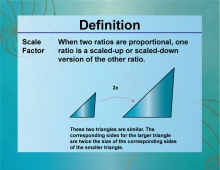
|
Definition--Ratios, Proportions, and Percents Concepts--Scale Factor | Scale FactorTopicRatios, Proportions, and Percents DefinitionA scale factor is a number that scales, or multiplies, some quantity. DescriptionScale factors are used in various applications, such as resizing images, models, and maps. For instance, if a model car is built at a scale factor of 1:24, it means the model is 1/24th the size of the actual car. This concept is crucial in fields requiring accurate scaling, such as architecture and engineering. |
Proportions |
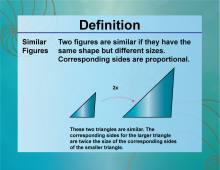
|
Definition--Ratios, Proportions, and Percents Concepts--Similar Figures | Similar FiguresTopicRatios, Proportions, and Percents DefinitionSimilar figures are figures that have the same shape but may differ in size; their corresponding angles are equal, and their corresponding sides are proportional. DescriptionSimilar figures are fundamental in geometry and are used in various real-world applications, such as creating scale models and maps. For example, two triangles are similar if their corresponding angles are equal and their sides are in proportion. This concept is essential for understanding geometric relationships and solving problems involving shapes and sizes. |
Proportions |

|
Definition--Ratios, Proportions, and Percents Concepts--Solving Proportions | Solving ProportionsTopicRatios, Proportions, and Percents DefinitionSolving proportions involves finding the value of a variable that makes two ratios equal. DescriptionSolving proportions is a key skill in algebra and is used in various applications, such as scaling recipes, converting units, and solving real-world problems. For example, if you know that 2/3 = x/6 you can solve for x by cross-multiplying to get 2 * 6 = 3 * x leading to x = 4 |
Proportions |
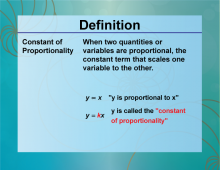
|
Definition--Ratios, Proportions, and Percents Concepts--The Constant of Proportionality | The Constant of ProportionalityTopicRatios, Proportions, and Percents DefinitionThe constant of proportionality is the constant value that relates two proportional quantities. DescriptionThe constant of proportionality is a fundamental concept in mathematics, particularly in linear relationships and direct variation. For example, in the equation y = kx, k is the constant of proportionality that relates y and x. This concept is crucial in fields like physics, where it is used to describe relationships such as speed (distance/time). |
Proportions |
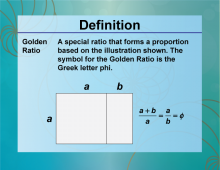
|
Definition--Ratios, Proportions, and Percents Concepts--The Golden Ratio | The Golden RatioTopicRatios, Proportions, and Percents DefinitionThe Golden Ratio is a special number approximately equal to 1.618, often denoted by the Greek letter φ (phi), which appears in various aspects of art, architecture, and nature. |
Applications of Ratios, Proportions, and Percents and Ratios and Rates |
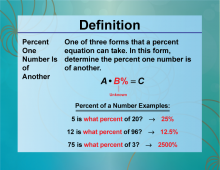
|
Definition--Ratios, Proportions, and Percents Concepts--The Percent One Number Is of Another | The Percent One Number Is of AnotherTopicRatios, Proportions, and Percents DefinitionThe percent one number is of another is a way to express one number as a percentage of another number. DescriptionUnderstanding how to express one number as a percentage of another is crucial in various real-world applications, such as calculating discounts, tax, and interest rates. For example, if you want to find out what percentage 25 is of 200, you divide 25 by 200 and multiply by 100, resulting in 12.5%. |
Percents |
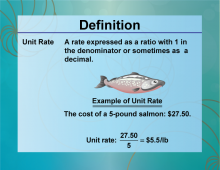
|
Definition--Ratios, Proportions, and Percents Concepts--Unit Rate | Unit RateTopicRatios, Proportions, and Percents DefinitionA unit rate is a comparison of any two separate but related measurements when one of the measurements is reduced to a single unit. DescriptionUnit rates are commonly used in everyday life, such as calculating speed (miles per hour), cost per item, or efficiency (miles per gallon). For example, if a car travels 300 miles on 10 gallons of gas, the unit rate is 30 miles per gallon. |
Ratios and Rates |
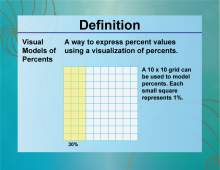
|
Definition--Ratios, Proportions, and Percents Concepts--Visual Models for Percents | Visual Models for PercentsTopicRatios, Proportions, and Percents DefinitionVisual models for percents are diagrams or illustrations that represent percentages to help visualize and understand them. DescriptionVisual models for percents are useful tools in various fields, such as education, finance, and statistics, to represent data and make it more comprehensible. For example, pie charts and bar graphs are common visual models that help illustrate percentages and proportions effectively. |
Percents |
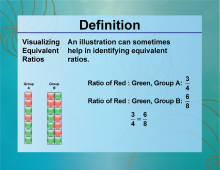
|
Definition--Ratios, Proportions, and Percents Concepts--Visualizing Equivalent Ratios | Visualizing Equivalent RatiosTopicRatios, Proportions, and Percents DefinitionVisualizing equivalent ratios involves using diagrams or models to show that two ratios are equivalent. DescriptionVisualizing equivalent ratios is important in fields such as mathematics and engineering, where understanding proportional relationships is crucial. For example, using a double number line or a ratio table can help illustrate that the ratios 2:3 and 4:6 are equivalent. |
Ratios and Rates |
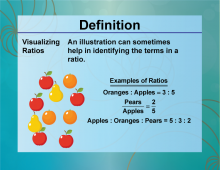
|
Definition--Ratios, Proportions, and Percents Concepts--Visualizing Ratios | Visualizing RatiosTopicRatios, Proportions, and Percents DefinitionVisualizing ratios involves using diagrams or models to represent and understand the relationship between two quantities. DescriptionVisualizing ratios is essential in various fields, such as mathematics, science, and economics, where understanding the relationship between quantities is crucial. For example, using a bar model or a double number line can help illustrate the ratio of 3:4. |
Ratios and Rates |

|
INSTRUCTIONAL RESOURCE: Algebra Application: Linear Functions: Circumference vs. Diameter | INSTRUCTIONAL RESOURCE: Algebra Application: Linear Functions: Circumference vs. Diameter
In this Algebra Application, students study the direction between diameter and circumference of a circle. Through measurement and data gathering students analyze the line of best fit and explore ways of calculating pi. The math topics covered include: Mathematical modeling, Linear functions, Data gathering and analysis, Ratios, Direct variation. This is a great back-to-school activity for middle school or high school students. This is also a great crossover activity that ties algebra and geometry. |
Applications of Linear Functions, Applications of Ratios, Proportions, and Percents and Applications of Circles |

|
INSTRUCTIONAL RESOURCE: Algebra Application: Why Are Receipts So Long? | INSTRUCTIONAL RESOURCE: Algebra Application: Why Are Receipts So Long?
In this Algebra Application, students gather data to study the lengths of paper receipts. They also learn to estimate the total number of receipts produced worldwide using industry data. From this they can study the environmental impact of having to produce so many paper receipts. The math topics covered include: Measures of central tendency (specifically the mean), Scientific notation, Rates, Converting different units. The culminating activity is for students to make a persuasive case to retailers about finding alternatives to paper receipts, using the data they gathered and analyzed. This is a great back-to-school activity for middle school or high school students. A relevant real-world application allows them to review math concepts. |
Laws of Exponents and Data Analysis |

|
INSTRUCTIONAL RESOURCE: Algebra Application: Why Are Wildfires So Dangerous? | INSTRUCTIONAL RESOURCE: Algebra Application: Why Are Wildfires So Dangerous?
In this Algebra Application, students learn about wildfires and the measurement of air quality. The math topics covered include: Scientific notation, Rates, Density, Data Analysis. The specific focus of this investigation is the health hazards from wildfire smoke. This includes a discussion of air density, measurement in microns, and measurement of air quality. Links to various web sites, including the EPA's site, provide relevant background information and data. The culminating activity is a case study of the wildfires in the Lake Tahoe area. Students analyze historical data and make a recommendation on the air quality. This is a great back-to-school activity for middle school or high school students. A relevant real-world application allows them to review math concepts. |
Laws of Exponents and Applications of Ratios, Proportions, and Percents |

|
INSTRUCTIONAL RESOURCE: Pumpkin PI | In this Slide Show, do a hands-on geometry activity to measure π. Note: The download is a PPT file. |
Ratios and Rates |
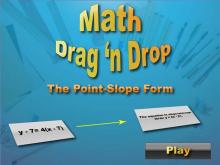
|
Interactive Math Game--DragNDrop--The Point-Slope Form | Interactive Math Game--DragNDrop Math--The Point-Slope Form
In this drag-and-drop game, match the linear equation in point-slope form with its slope-intercept counterpart. This game generates thousands of different equation combinations, offering an ideal opportunity for skill review in a game format. This is part of a collection of math games and interactives. To see the complete collection of the games, click on this link. Note: The download is the teacher's guide.Related ResourcesTo see additional resources on this topic, click on the Related Resources tab. |
Point-Slope Form |

|
Interactive Math Game--DragNDrop--The Slope Formula | Engaging Math Activities & Games For Learning Slope
In this drag-and-drop game, match the coordinates to the slope of the line that passes through the two points. This game generates thousands of different equation combinations, offering an ideal opportunity for skill review in a game format. Improve math skills and have fun at the same time with our selection of interactive games and activities that teach the concept of slope. These entertaining games make learning enjoyable and engaging, helping young learners understand this mathematical process better. |
Slope |